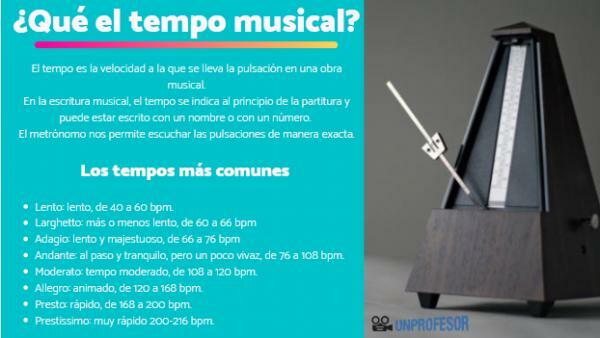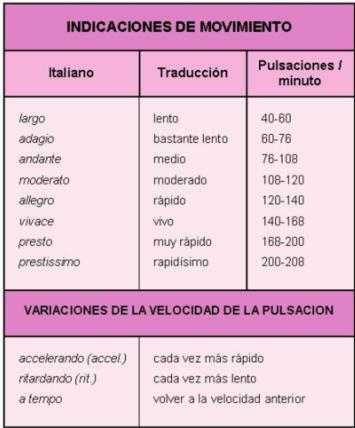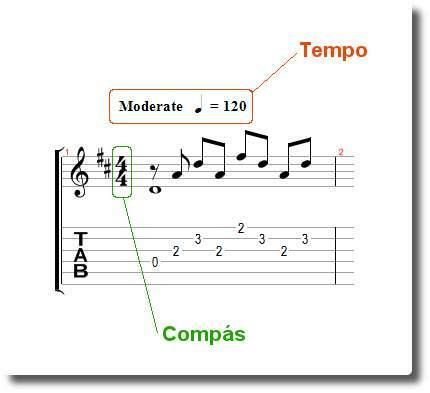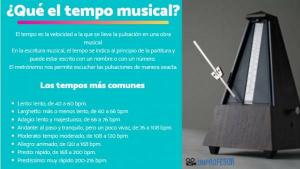What is TEMPO in music

Music is a wonderful art, as it is a multidimensional discipline. By this we mean that, when it comes to sound, we use several elements in its favor thanks to the properties that this natural phenomenon gives us. Sound has characteristics such as tuning and when coupled with others it forms harmony, but then we also have an essential factor for music: time or tempo.
In this lesson from a TEACHER you will learn precisely about what is the tempo, how important it is and how we understand it in music.
Index
- Definition of tempo in music
- Types of musical tempo
- Understand the tempo indication in a score
- What is the role of time in music
Definition of tempo in music.
Tempo is speed to which it takes the pulsation in a musical work. Speed is an important factor in music, since the way we interpret and perceive a work depends on it. It is not the same to listen to a song in a very slow way than in a fast and accelerated way. Tempo is an element that is established in formal works.
Measuring the musical tempo
In musical writing, the tempo is indicated at the beginning of the score and it can be written with a name or with a number. In the case of the number, this measure is indicated using the acronym bpm, which comes from the English words “beats per minute”, that is to say “beats per minute”. The higher the number, the faster the speed.
We were able to obtain these numbers thanks to a device called metronome, which allows us to hear the pulsations exactly. The metronome is an essential tool for music students and professionals that allows us to control our tempo.
In the past, prior to the invention of the metronome, the speed of interpretation of a work was approximate and used Italian names to designate different types of tempo, of which many remain in the present.
Types of musical tempo.
We list here the tempo names, also taking into account the bpm, which has become standardized over time and even not only in speed, but also in the character of the performance of a work. By this we mean that speed is not only a technical aspect, but is also accompanied by an intention certain expressive qualities that are sometimes described in the score (such as sadness, majesty, vivacious, etc.).
The common and general tempos They are
- Slow: slow, 40 to 60 bpm.
- Larghetto: more or less slow, 60 to 66 bpm
- Adagio: slow and majestic, 66 to 76 bpm
- Andante: at a pace and calm, but a bit lively, from 76 to 108 bpm.
- Moderate: moderate tempo, from 108 to 120 bpm.
- Allegro: lively, 120 to 168 bpm.
- Presto: fast, from 168 to 200 bpm.
- Prestissimo: very fast 200-216 bpm.
Other tempos in music
- Larghissimo: extremely slow, less than 20 bpm.
- Long: very slow, 20 bpm.
- Afettuous: 72 bpm.
- Allegretto: moderately animated.
- Vivace: vivacious.
- Allegro prestissimo with fuoco: extremely fast, over 240 bpm.

Image: Classroom of musical language
Understand the indication of tempo in a score.
The tempo in a score is usually indicated above the first measure of the staff, and can simultaneously have the bpm as well as the performance name.
The bpm will indicate a number but we must also be pay attention to the base musical figure, because depending on this the boom must be interpreted. The standard figure that is usually used is the black one, but the white or another figure can also be indicated less frequently. For example, if the tempo indicates that the quarter note = 60bpm, this means that we will have 60 quarter notes in 1 minute, the quarter note would equal 1 second.
In the other case, if the tempo indicates that the white = 60bpm, this means that there are 60 white in 1 minute. Since the white equals twice the beats of a quarter note, the tempo would then be twice as fast (120 quarter notes per minute, the quarter note equals half a second).

Image: Acoustic Guitar Blog
What role does time have in music?
The weather it is a crucial factor in the perception of music. It is not the same to interpret the same work slowly as quickly, since we usually associate speed with certain qualities. A slow piece can communicate peace or nostalgia, while a fast piece can infect us with agitation or tension. Even within the same work the tempo can change, looking for a way of expression or development.
We can finally say that setting a tempo allows the feeling of a work to be maintained each time it is performed and this may be of interest to the composer of the work or to be related to the musical genre
Now that you know what tempo is, you will have one more tool to take into account to interpret, study and listen to music. If you have access to a metronome, which today is very easy to get even digitally, you will We recommend that you spend a moment exploring it to get a better approach to what you just learn.
If you want to read more articles similar to What is tempo, we recommend that you enter our category of Musical language.


